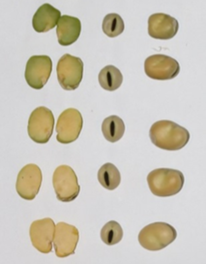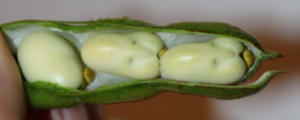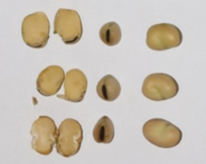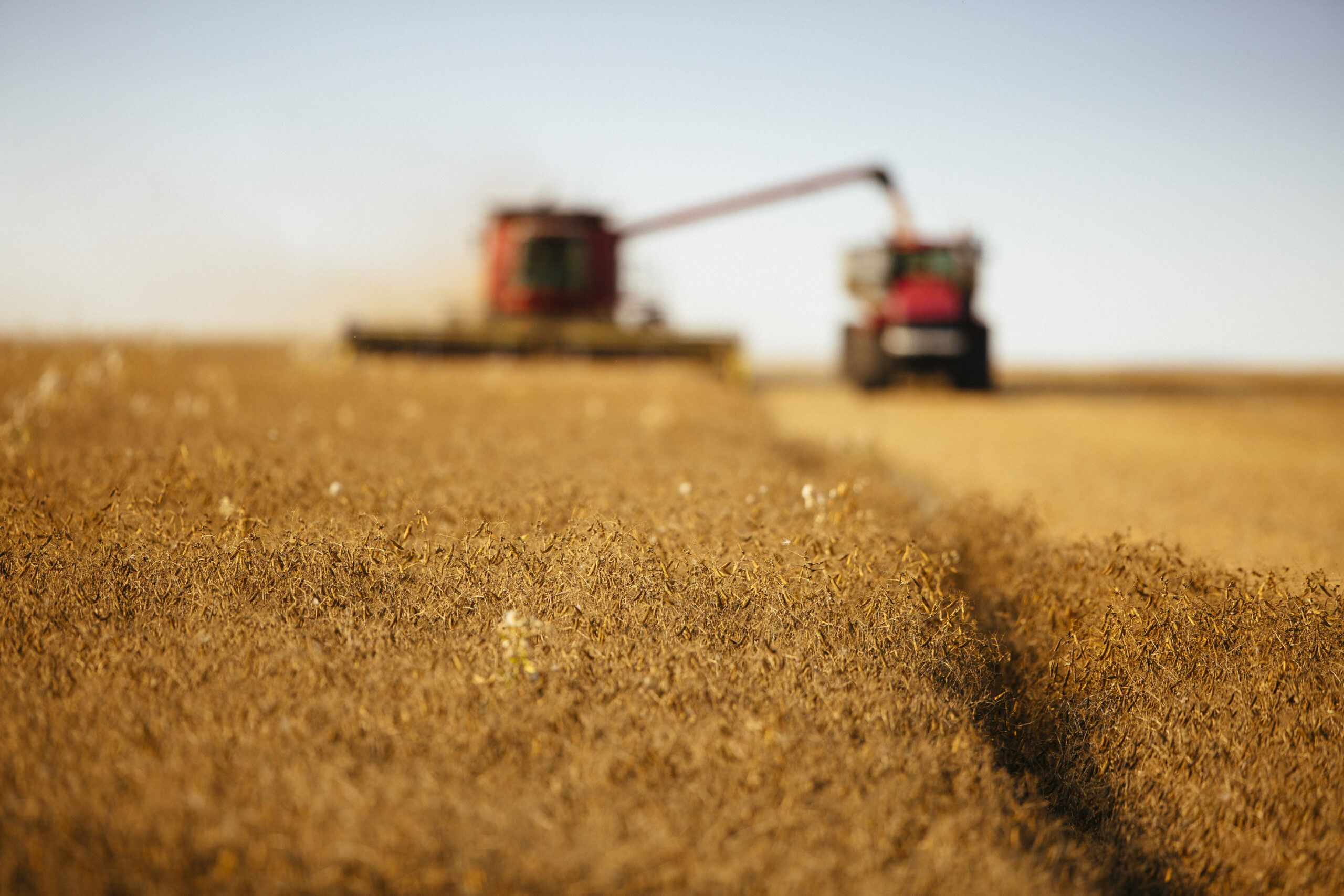Harvest Aids

Desiccants can be used to dry down faba beans more quickly. Glyphosate can also be used to aid in weed control prior to harvest. All harvest aids must be applied when the crop is at 30% moisture or less. At this stage 80% of the pods on the faba bean will have started to turn colour with the bottom one-third of the pods completely turned with seeds that have changed colour and are hard. Middle pods will have seeds that also have colour change and are tough to split. Top pods will contain seeds that are firm and can split cleanly in two halves without juice being presenT. Faba beans start to lose their leaves from the bottom up and harvest aid timing is usually associated with 80-90% leaf drop when there are leaves left mainly at the top of the plant. Stems will have started turning colour to the tan/yellow/brown as the crop dries down. Faba beans tend to be variable in their staging as harvest approaches, so some plants will be completely turned and some will have more green pods.
When moisture is limiting, the crop can turn on its own with no need for harvest aids. However, in areas where moisture is sufficient and the crop is slow to turn, a harvest aid may be warranted to help bring the crop in prior to frost.
The crop can be swathed when the Lowest one to three pods on the main stem have turned dark brown or black, across 25% of the field. By this time, the uppermost pods should be fully developed and the middle pods will be turning light green. At this stage, the moisture content of the most mature seeds may be over 40% and the seeds in the upper part of the plant may have moisture content over 60%.
Faba Bean Staging for Harvest Management
Faba beans mature in 110 to 130 days depending on moisture conditions. As the crop matures, the lower leaves darken and drop, and the bottom pods turn black and dry from the bottom to the top of the plant.
Glyphosate can be sprayed when the seed has less than 30% moisture content. At this stage, faba bean stems are green to brown, pods are yellow to brown, and 80-90% of the leaves have dropped.
Diquat is a registered desiccant for faba beans. Diquat should be applied when most plants are ripe and dry. At this stage, pods are fully filled and the bottom pods will be tan or black in colour. Always read and follow label directions prior to application.
The crop can be swathed when the lowest one to three pods are turning dark, in about 25% of the plants. By this time, the uppermost pods should be fully developed and the middle pods will be turning light green. At this stage, the moisture content of the most mature seeds may be over 40% and the seeds in the upper part of the plant may have moisture content over 60%.
Table 1. Various Stages of Maturity for Faba Bean Seed
 |
 |
· Seed too immature (soft) |
 |
 |
· Seed firm and hilum darkening but moisture content above 60% |
 |
 |
· Seed fully formed. Hilum darkened and seed starting to yellow in centre. Seeds are physiologically mature. Seeds at this stage at the top of the plant are ready for dry down to reach harvest moisture levels. |
 |
 |
· Mature seeds. Stage of seed at the bottom of the plant when at the correct stage for harvest management. Pods are difficult to break open and seed is still a bit soft |


Source: Devon Walker, Walker Seeds, Lashburn, Sask.
Combining
Faba beans should be combined when moisture content is at 18-20%. The seed coat of faba beans is tougher than peas, but care should still be taken to handle them gently to prevent mechanical damage. Combines should be set with maximum clearance and reduced cylinder or rotor speed of 300-400 revolutions per minute (rpm). Harvested seed should be aerated to 16% for long-term safe storage, but will store overwinter at 18%.
Overwintering Faba Beans
When weather does not cooperate, faba beans are not drying down, or there is no more room in aeration bins, an option is to leave them out in the field. Growers have successfully combined faba beans during the winter and into the spring. One of the biggest challenges is making sure the ground is either still frozen or dry enough to prevent the combine from getting stuck. Combining at night when ground is frozen has worked for some growers, but be careful around the sloughs. Combining when there is snow on the ground is also an option as the pods tend to be at least six inches off the ground. Losses from overwintering appear to be minimal in most cases as faba beans hold their pods fairly well and the only shattering is where the knife comes in contact with the pods. If the snow is deeper or pods are lower, there can be losses due to the inability to cut beneath the lowest pods. Snow drifts around trees and field edges or hills can limit accessibility. Wildlife feeding overwinter can result in damages and losses.

Source: Terrel Hill, Medstead.
Storage
Storing faba beans at high moistures can be a challenge. Storing at 18-20% moisture can be successful as long as the grain is cooled. Higher moisture content can lead to hot spots in the bin and the grain needs to be cooled quickly and will store as long as the temperatures are well below zero (in the bin and outside of the bin). Once temperatures start warming up the grain should be dried down to 16% moisture.
Drying
With a long season crop it often means the crop is taken off tough or even at higher moisture and will require drying. There is virtually no research on drying faba beans and most of the suggestions originated from work with dry beans, which have different seed characteristics and different markets and quality requirements. This document outlines what we have learned from previous growing seasons with faba beans.

Source: D. Walker, Lashburn, Sask.
Aeration
Aerating faba beans can be a challenge if the faba beans are higher than 20% moisture, and when air temperatures have cooled and/or humidity is high. Attempts to aerate late harvested faba beans can result in condensation freezing to occur on aeration fans (Figure 4).
Using external heat sources in combination with aeration bins can help to bring down moisture in faba beans in cases where dryers are not accessible.
Drying Using Grain Dryers
Drying faba beans from mid-20% moisture needs patience. A maximum of 32°C (87°F) is recommended based on research with dry beans where higher temperatures affected quality for food grade markets. With faba beans for feed the temperature may not be so critical as long as nutritive values are not affected. Drying at high temperatures can also impact the germination which is important if seed is it to be used for planting next season. If quality is already lower grade (which is often the case with late harvest or feed grade), then temperatures are not as critical.

Source: Terry Pylot, Meadow Lake, Sask., March 2020
If you are targeting dropping the moisture by more than 5%, it should be done in two stages as the large seeds need time to equalize and move moisture from inside the seed to the outer surfaces.
Successful drying of 20-22% moisture faba beans has been accomplished in Saskatchewan with various drying systems from batch to continuous flow dryers, and with a range of temperatures from 110-195°F. The less you are concerned with quality, the higher the temperature that can be used. For food or seed grade low temperatures and slower drying is important. For feed or sample faba beans the temperatures are not as critical but be careful not to cook the beans.
In Summary
Faba bean harvest can occur in the fall, winter, or spring. It is easier to let Mother Nature dry down the crop in the field than have to dry the crop using an external drying system. Having patience is key as they will stand well through the winter, and there has been a lot of success even combining in the snow.



